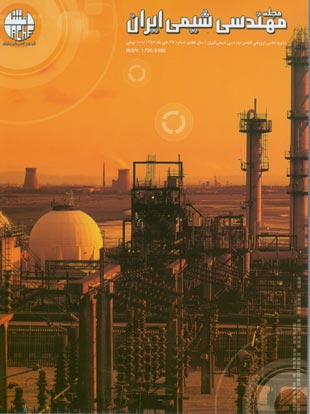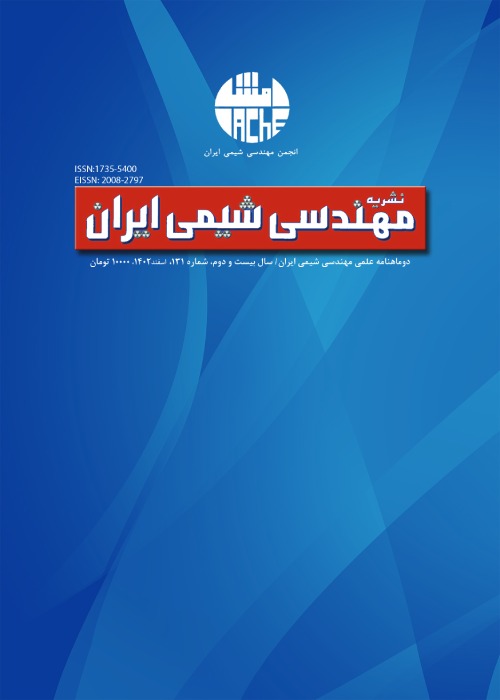فهرست مطالب

دوماهنامه مهندسی شیمی ایران
پیاپی 37 (آذر و دی 1387)
- 100 صفحه، بهای روی جلد: 10,000ريال
- تاریخ انتشار: 1387/11/05
- تعداد عناوین: 10
-
- سرمقاله
- مقالات
-
صفحه 3اکثر پساب های صنعتی دارای مقادیر بسیار بالایی نمک هستند. تصفیه پساب های نمکی ساده نمی باشد. روش های بیولوژیکی برای این آب ها به علت بازدارندگی نمک در رشد میکروبی خیلی رضایت بخش نیست. اما پساب های نمکی به علت وجود آنیون ها و کاتیون ها، هدایت بالایی دارند و لذا استفاده از روش های الکتروشیمیایی، مناسب می باشد. در این تحقیق، استفاده از روش الکتروشیمیایی در تصفیه پساب و پارامترهای موثر بر راندمان روش الکتروشیمیایی در حذف COD نظیر هدایت پساب، pH و دانسیته جریان، دما و غلظت، مورد بررسی قرار گرفته اند.
کلیدواژگان: روش الکتروشیمیایی، اکسیژن مورد نیاز شیمیایی، پساب نمکی، تصفیه پساب -
صفحه 12مفهوم نانوسیال سوسپانسیون های حاوی نانوذرات مواد را شامل می شود که می توانند به عنوان محیط های انتقال حرارت در سیستم رادیاتور و روغن موتور وسایل نقلیه استفاده شوند. در این بررسی در مورد عوامل کاهش بهره وری مصرف سوخت کامیون ها، نقش نانوسیال به عنوان عامل خنک کننده در رادیاتور و سیستم روغن موتور و مشکلات احتمالی کاربرد نانوسیال بحث شده است. نتایج مطالعات بیانگر آن است که با افزودن نانوذرات به سیستم رادیاتور و روغن موتور اتومبیل ها علاوه بر بهبود انتقال حرارت و کاهش 11 درصدی مصرف سوخت، کاهش بیشتر ضریب اصطکاک با افزودن نانوذرات به این سیستم ها مشاهده می شود.
کلیدواژگان: نانوسیال، بهینه سازی مصرف سوخت، افزایش انتقال حرارت، کاهش اصطکاک، نانوذرات -
صفحه 29به طور کلی غشاها فیلم های نازکی از مایع یا جامد نظیر یک پلیمر، سرامیک یا فلز می باشند که در جداسازی مواد مختلف کاربرد دارند. در سال های اخیر خانواده جدیدی از غشاها به نام غشاهای هادی در زمینه های گوناگون مورد توجه قرار گرفته اند. برای تهیه غشاهای هادی دو روش اصلی پیشنهاد شده است. روش اول؛ عبارت است از به کار بردن پلیمرهای ذاتا هادی و روش دوم؛ اصلاح غشاهای غیرهادی با پوشاندن سطحشان توسط مواد هادی مثل فلز و یا پلیمرهای هادی است. با تعیین ویژگی هایی نظیر میزان هدایت، تخلخل، خواص مکانیکی، نحوه انتقال گونه های مختلف از غشا و... میزان کارایی آن برای استفاده در فرایندی معین تعیین می گردد.
کلیدواژگان: عشای هادی، روش های تهیه، تعیین ویژگی ها، پلیمرهای هادی -
صفحه 40
فرایند پودرسازی برشی حالت جامد پلیمرها روشی نوین در عملیات فرایندی پلیمرها برای تولید مواد جدید می باشد. با بکارگیری موفقیت آمیز این روش، می توان شاهد تحولی در صنایع مختلف پلیمرها بویژه در صنایع بازیافت پلیمرها، فرایند کامپاندینگ، و بهبود خواص مکانیکی شیمیایی بود. در این فرایند، پیوسته یک مرحله ای پلیمرها در معرض نیروهای برشی و فشاری قرار می گیرند و مصرف انرژی کمتری دارند. در این مقاله، ضمن تشریح این فرایند و کاربردهای مختلف آن در صنایع پلیمری، نقاط برتری آن نسبت به روش های موجود بررسی می شوند.
کلیدواژگان: پودرسازی برشی حالت جامد پلیمرها، بازیافت پلیمرها، کامپاندینگ -
صفحه 47عدم نیاز به حلال آلی یا نیاز به مقدار بسیار کمی حلال آلی مهم ترین ویژگی استخراج با آب فوق داغ بشمار می رود. در دسترس بودن، ارزان بودن و غیر سمی بودن آب به عنوان حلال اصلی و همچنین عدم نیاز به خشک کردن نمونه های مرطوب از دیگر ویژگی های این روش است. در بسیاری از موارد استخراج با آب فوق داغ نسبت به سایر روش های معمول استخراج، روشی ارزان تر، پاک تر و سریع تر می باشد. در این مقاله، ابتدا کلیات استخراج با آب فوق داغ شامل تغییر خواص آب با دما، روش استخراج و سیستم های مورد استفاده، پارامترهای موثر بر استخراج و مقایسه کلی این روش با سایر روش های معمول استخراج مورد بررسی قرار گرفته است. سپس شرایط استخراج و نحوه آنالیز نمونه بدست آمده، در استخراج پلی فنول ها و ترکیبات فنولی، آنتی اکسیدان ها، اسانس ها و سایر ترکیبات مفید از گیاهان و مواد غذایی با سیستم آب فوق داغ، ارائه شده است.
کلیدواژگان: آب فوق داغ، استخراج، کاربرد، گیاهان -
صفحه 64افزایش تعداد وسایل نقلیه، استفاده از سوخت های پاک مانند گاز طبیعی را به عنوان یکی از راه های مبارزه با آلودگی هوا بسیار مورد توجه قرار داده است. متاسفانه گاز طبیعی به لحاظ میزان انرژی در واحد حجم در رده بسیار پایین تری نسبت به بنزین قرار می گیرد. به همین دلیل محققین به دنبال روش های ایمن و ارزان قیمتی هستند تا بتوانند مقادیر زیاد گاز را در کمترین حجم ممکنه ذخیره و همچنین منتقل نمایند. روش های مختلف ذخیره سازی و انتقال گاز طبیعی بسته به نوع مخزن گازی، مسافت آن تا بازارهای مصرف، میزان سرمایه گذاری و سایر پارامترهای عملیاتی، هر کدام از خصوصیات ویژه ای برخوردار می باشند. در این مقاله، سه روش گاز طبیعی فشرده شده1، گاز طبیعی جذب شده2 و هیدرات گاز طبیعی3 به عنوان سه راهکار پیشنهادی جهت استفاده از گاز در اتومبیل ها و همچنین به عنوان راه هایی جهت حمل و نقل آن در مقیاس زیاد از طریق دریا، از جنبه های مختلف مورد بررسی و مقایسه قرار گرفته اند.
کلیدواژگان: ذخیره سازی، انتقال، گاز طبیعی فشرده شده، جذب، هیدرات -
صفحه 75آرسنیک فلز سمی و خطرناکی است که به طور طبیعی در آب های سطحی و زیرزمینی بسیاری از نقاط زمین یافت می شود و اثرات آن بر سلامتی انسان جبران ناپذیر است. با توجه به اینکه کارایی سیستم های تصفیه متداول برای دستیابی به استاندارد کمتر از μg/l 10 مناسب نیست؛ لذا باید از روش های جدیدی استفاده کرد که هم اقتصادی بوده و هم بتواند غلظت آرسنیک را تا زیر این مقدار کاهش دهد. فرایند انعقاد الکتریکی از لحاظ اقتصادی و محیط زیستی، یک انتخاب برتر برای سیستم های تصفیه آب و فاضلاب می باشد. در فرایند انعقاد الکتریکی، الکترود فناشونده (آند) بتدریج از بین می رود تا مواد اولیه منعقدکننده بوجود آیند. در این مقاله، شیوه حذف آرسنیک از آب آشامیدنی به روش انعقاد الکتریکی و عوامل موثر بر آن مورد بررسی قرار گرفته اند. بررسی ها نشان می دهند که الکترود آهن بهترین جواب را در حذف آرسنیک داشته و نیز وجود آن در آب موجب بروز مشکل نمی شود.
کلیدواژگان: انعقاد الکتریکی، تصفیه الکتروشیمیایی، تصفیه آب، فلزات سنگین، حذف آرسنیک - معرفی، اخبار و گزارش ها
-
صفحه 89
-
صفحه 95
-
Page 3Many industrial wastewaters have been found to be highly saline content. Treatment of saline wastewater has not been easy. Biological methods are the tradition has revealed that the biological method may not be a good choice, primarily because of the inhibitory effect of high salinity on the microbial growth. With high saline content, the wastewater invariably has a rather high conductivity, because of the presence of anions and cations in the aqueous solution. Therefore, this method has been successfully employed with various types of industrial wastewater. In this paper, treatment of wastewaters by electrochemical method has been investigated. Also, the several aspects such as wastewater conductivity, PH and current density, temperature and concentration are explored to determine their effect on the treatment efficiency.
-
Page 12The term of nanofluids refers to a new kind of fluids by suspending nanoparticles in base fluids, which can be employed in radiator and motor oil system. In this study the effective factors responsible for vehicle fuel low efficiency, the rule of nanofluid as cooling fluid in radiator and motor oil system and the probably challenges encountered in using nanofluid was investigated. The review of investigation expressed that adding nanoparticles to vehicle radiator and motor oil system besides of heat transfer improvement and 11% fuel efficiency, more friction factor decreasing can be available using nanofluid as a new coolant.
-
Page 29Generally, the membrane is a thin film of liquid, or more commonly solid, from polymer, ceramic or metal. In recent years, interests in the preparation and application of new family of membranes called conducting membranes have grown in various fields. For the preparation of conducting membranes, two major techniques have been introduced. The first procedure includes employment of intrinsic conducting polymers and the second procedure is modification of the prepared non-conductive membranes by coating the conducting materials like metal or conducting polymers on the surface of non-conductive membranes. Various characteristics tools including conductivity, porosity, mechanical properties, and transport of various materials across the membrane and etc. can be applied for determining the membrane characteristics.
-
Page 40
Solid state shear pulverization is a novel technology in polymer processing for production of new polymeric materials. By implementation of this technology various processes such as polymer recycling, compounding, and improving of mechanical-chemical properties of polymers can be enhanced. This is a continuous and one-stage process with low energy consumption. During this process, polymers are subject to high pressure and shear forces. In this paper, this technology and its applications to polymer processing is presented.
-
Page 47Superheated water extraction has been shown to be feasible with particular interest in avoiding the need for organic solvents. The method is cheap and non-toxic. Also the wet sample doesn’t need to be dried before extraction. Because of these characteristics this method has been more effective than traditional methods in many cases. In this article, brief introduction of the method has been provided which includes information about the extraction system and the parameters which affect extraction efficiency. Also extraction condition and analysis method of the extracts have been studied for extraction of polyphenols and phenolic compounds, antioxdants, essential oils and other compounds from plants.
-
Page 64Due to the substantial growth of transportation vehicles, utilization of green fuels such as natural gas is regarded as one of the challenging ways against air pollution. Unfortunately, natural gas is far behind the gasoline in terms of energy per unit volume. Therefore, some alternative safe and low cost techniques are under investigation to store and transport gas in a least possible volume. Different gas storage and transportation techniques are depend upon the gas reservoir, distance to consumption market, total investment and other operation parameters and each one has its own specification. In this article, three methods of compressed natural gas (CNG), adsorbed natural gas (ANG) and natural gas hydrate (NGH) as alternative techniques for natural gas storage in vehicles as well as effective means of transporting large amounts of natural gas by ships, are considered and compared in different aspects.
-
Page 75Arsenic is naturally a toxic metal and is found in surface and ground water of many parts of the world. Due to the low efficiency of conventional treatment methods for achieving the standard of level (10 μg/l), it is necessary to find a new and economical method to reach this standard. Electrocoagulation process is the distinct economical and environmental choice for water and wastewater treatment. In a typical electrocoagulation process, a sacrificial electrode (Anode) is decaling to release coagulant precursors into solution. In this paper, electrocoagulation process and its affecting factors has been discussed as an effective method for arsenic removal from drinking water. The desired results were obtained by iron electrodes, which are the safest electrodes in this treatment process.


